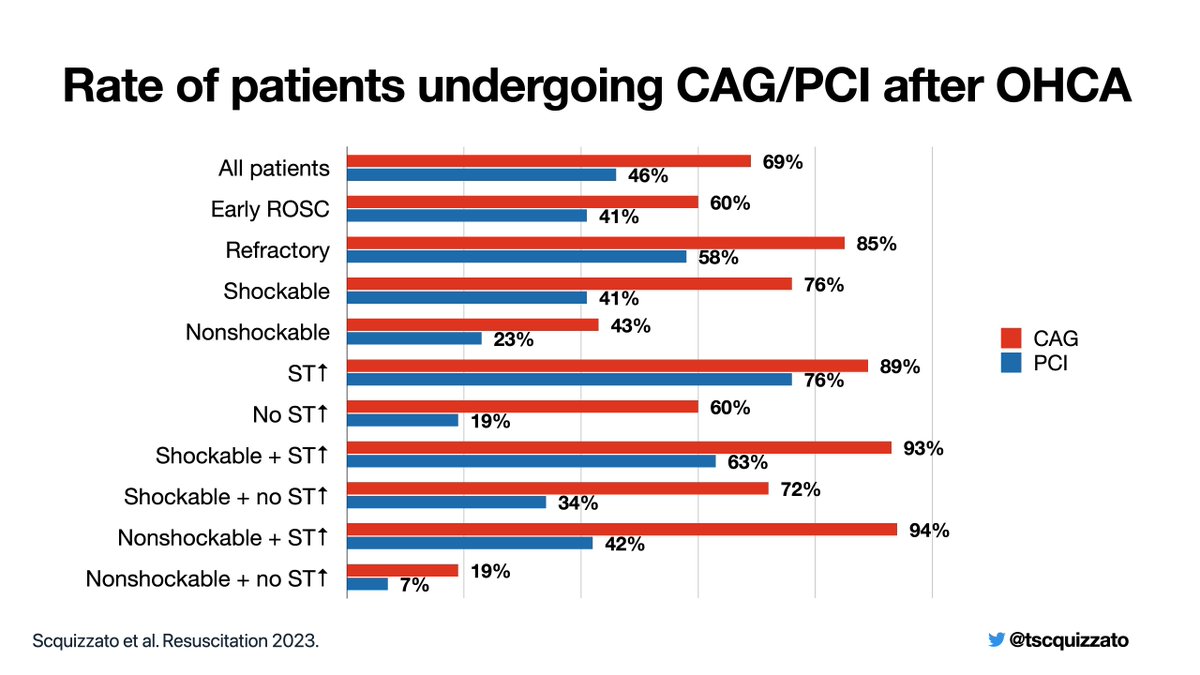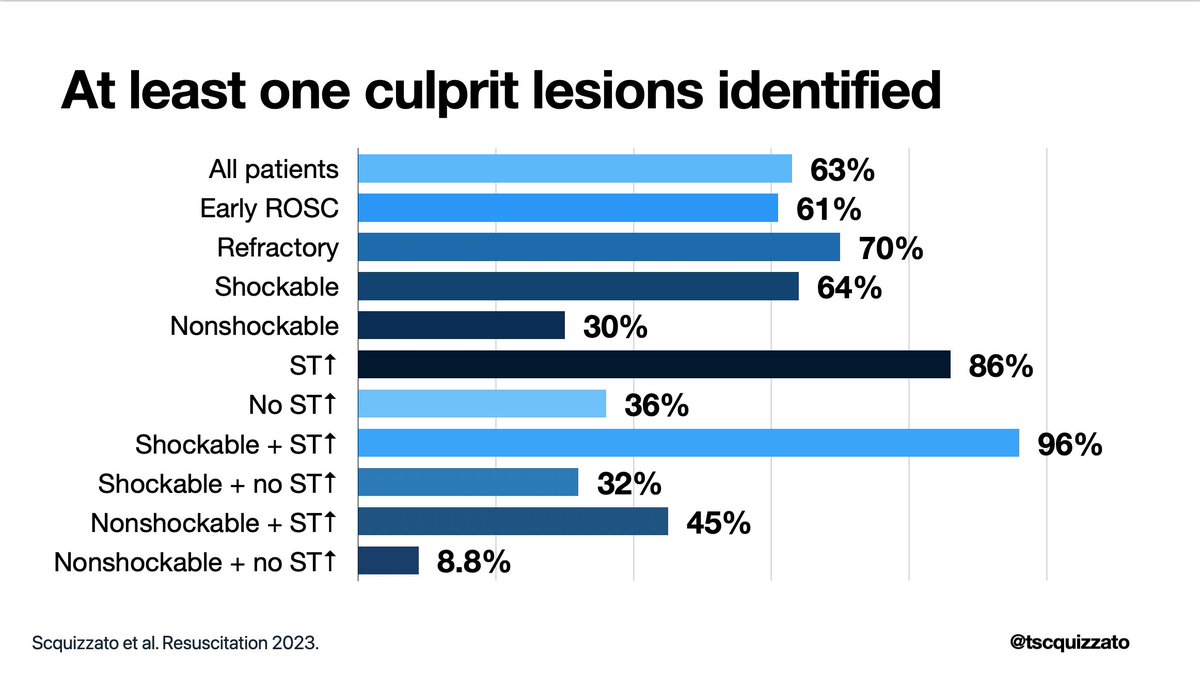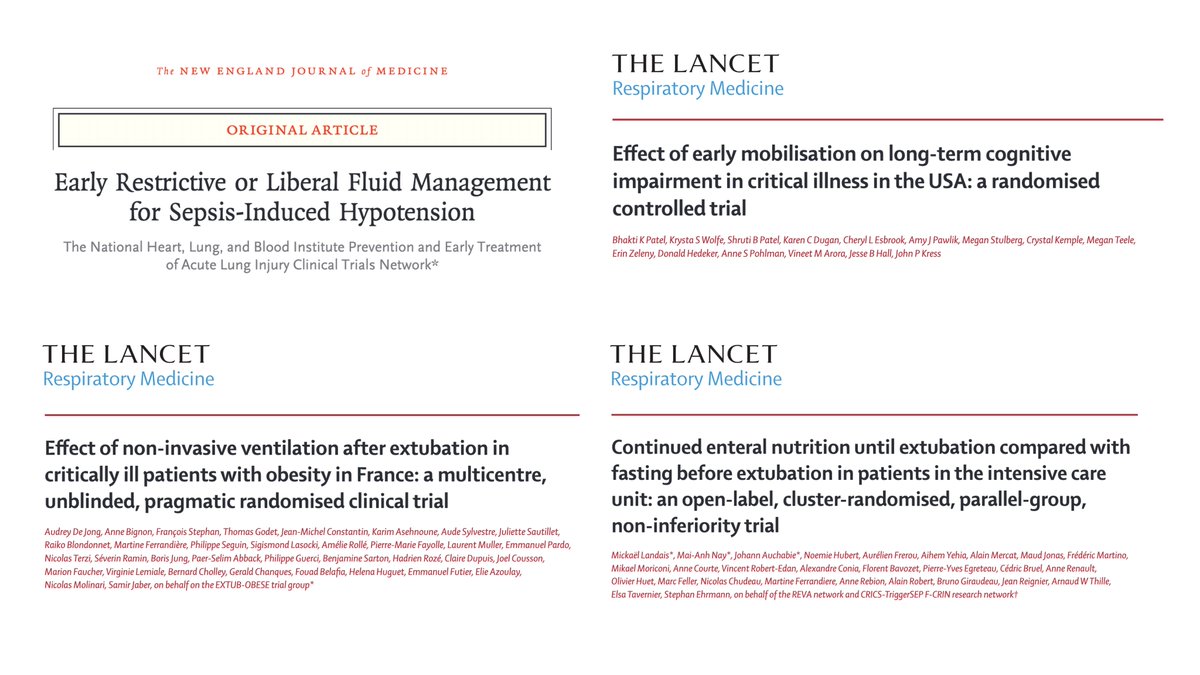WHAT ARE THE FINDINGS OF CAG AFTER OHCA?🫀
We performed a SRMA of 128 studies (>62k pts) to describe angiographic features in resuscitated and refractory OHCAs
We found that
🔸 significant CAD is present in 75%
🔸 CAD is more severe in refractory OHCA
🔸 CAD is common also in… twitter.com/i/web/status/1…
We performed a SRMA of 128 studies (>62k pts) to describe angiographic features in resuscitated and refractory OHCAs
We found that
🔸 significant CAD is present in 75%
🔸 CAD is more severe in refractory OHCA
🔸 CAD is common also in… twitter.com/i/web/status/1…

@giovannilandoni @NickJohnsonMD @expensivecare @Pipes_n_pumps @EduardArgudo @CritCareReviews @jas_soar @krychtiukmd @PabloJ @proftomquinn 2/
Although the high frequency of CAD in OHCAs is well known and numerous studies were published, use and findings of CAG are variable and often described only in some subgroups of patients
Type/frequency of coronary lesions in OHCA pts were not summarized before
#ResusTwitter
Although the high frequency of CAD in OHCAs is well known and numerous studies were published, use and findings of CAG are variable and often described only in some subgroups of patients
Type/frequency of coronary lesions in OHCA pts were not summarized before
#ResusTwitter
@giovannilandoni @NickJohnsonMD @expensivecare @Pipes_n_pumps @EduardArgudo @CritCareReviews @jas_soar @krychtiukmd @PabloJ @proftomquinn 3/
We conducted a systematic review with meta-analysis of proportions combining CAG findings from 128 studies (62k patients), including refractory OHCA
Nine subgroups were analyzed for a more accurate description of CAG use and findings
📄 resuscitationjournal.com/article/S0300-… #ResusTwitter
We conducted a systematic review with meta-analysis of proportions combining CAG findings from 128 studies (62k patients), including refractory OHCA
Nine subgroups were analyzed for a more accurate description of CAG use and findings
📄 resuscitationjournal.com/article/S0300-… #ResusTwitter

4/
Before mechCPR/ECPR, CAD was predominantly described in patients with prehospital ROSC who underwent CAG.
Prolonged or refractory cardiac arrests usually resulted in on-scene death and thus did not receive CAG, which biased the description of CAD burden.
#ResusTwitter
Before mechCPR/ECPR, CAD was predominantly described in patients with prehospital ROSC who underwent CAG.
Prolonged or refractory cardiac arrests usually resulted in on-scene death and thus did not receive CAG, which biased the description of CAD burden.
#ResusTwitter
5/
Thanks to the possibility to transport patients with ongoing CPR for ECPR and CAG/PCI, we now have CAD data also for patients with prolonged OHCAs.
Combining for the first time also refractory OHCA patients allowed to have a more complete description of CAD
#ResusTwitter
Thanks to the possibility to transport patients with ongoing CPR for ECPR and CAG/PCI, we now have CAD data also for patients with prolonged OHCAs.
Combining for the first time also refractory OHCA patients allowed to have a more complete description of CAD
#ResusTwitter
6/
We found that CAG was performed in 69%, PCI in 46%
Patients with ST↑ and ST↑ + shockable rhythm were those receiving CAG/PCI more frequently
Patients with nonshockable rhythm and no ST↑ were those receiving CAG/PCI less frequently
#ResusTwitter
We found that CAG was performed in 69%, PCI in 46%
Patients with ST↑ and ST↑ + shockable rhythm were those receiving CAG/PCI more frequently
Patients with nonshockable rhythm and no ST↑ were those receiving CAG/PCI less frequently
#ResusTwitter

7/
We found that in patients undergoing CAG after OHCA 75% had at least one significant stenosis
In 30% was a 1-vessel disease and in 46% a multivessel disease
24% had normal coronaries or non-significant CAD
LAD was the most frequently involved coronary artery
#ResusTwitter

We found that in patients undergoing CAG after OHCA 75% had at least one significant stenosis
In 30% was a 1-vessel disease and in 46% a multivessel disease
24% had normal coronaries or non-significant CAD
LAD was the most frequently involved coronary artery
#ResusTwitter


8/
We found that in 63% of OHCA patients undergoing CAG a culprit lesion was identified (LAD in 34%)
Culprit lesions were more frequent in shockable and ST-elevation cases
~9% of patients with nonshockable initial rhythm and no ST-elevation had a culprit lesion
#ResusTwitter

We found that in 63% of OHCA patients undergoing CAG a culprit lesion was identified (LAD in 34%)
Culprit lesions were more frequent in shockable and ST-elevation cases
~9% of patients with nonshockable initial rhythm and no ST-elevation had a culprit lesion
#ResusTwitter


9/
We found that 43% of OHCA patients had ≥1 acute coronary occlusion, more frequently in pts with ST↑ after ROSC
LAD was the most frequent acute coronary occlusion (21%)
18% of patients had at least 1 chronic total occlusion, most frequently in the RCA (16%)
#ResusTwitter



We found that 43% of OHCA patients had ≥1 acute coronary occlusion, more frequently in pts with ST↑ after ROSC
LAD was the most frequent acute coronary occlusion (21%)
18% of patients had at least 1 chronic total occlusion, most frequently in the RCA (16%)
#ResusTwitter




10/
We found that patients with refractory OHCA, compared with early ROSC, had:
higher rate of pre-arrest chest pain
higher use of CAG/PCI
higher rate of LM involvement: >50% stenosis in 17% and LM as the culprit in 12%
higher rate of LAD acute occlusion (27%)
#ResusTwitter
We found that patients with refractory OHCA, compared with early ROSC, had:
higher rate of pre-arrest chest pain
higher use of CAG/PCI
higher rate of LM involvement: >50% stenosis in 17% and LM as the culprit in 12%
higher rate of LAD acute occlusion (27%)
#ResusTwitter

11/
Our data suggest that the underlying disease of refractory OHCA is frequently a more severe and complex myocardial ischemia
This could also be a substrate for a shock-refractory VFib
AMSA values in the future could help to rapidly identify these patients
#ResusTwitter
Our data suggest that the underlying disease of refractory OHCA is frequently a more severe and complex myocardial ischemia
This could also be a substrate for a shock-refractory VFib
AMSA values in the future could help to rapidly identify these patients
#ResusTwitter

12/
Our data also show that many pts had CS and required MCS even when ROSC was rapidly achieved or in the absence of ST↑
This reminds the importance of transporting OHCAs to Cardiac Arrest Centres capable of offering all the diagnostic and treatment options
#ResusTwitter
Our data also show that many pts had CS and required MCS even when ROSC was rapidly achieved or in the absence of ST↑
This reminds the importance of transporting OHCAs to Cardiac Arrest Centres capable of offering all the diagnostic and treatment options
#ResusTwitter
13/
It is important to note that only few studies performed CAG in all admitted patients → selection biases ⚠️ → limit the generalizability and certainty of estimates
Repeating analyses including only these studies did not showed clinically relevant differences
#ResusTwitter
It is important to note that only few studies performed CAG in all admitted patients → selection biases ⚠️ → limit the generalizability and certainty of estimates
Repeating analyses including only these studies did not showed clinically relevant differences
#ResusTwitter
14/
In clinical practice, the value of immediate CAG is established in patients with ST↑ after OHCA
In patients without ST↑ on post-ROSC ECG, guidelines recommend emergency CAG in case of high probability of ACS (hemodynamic or electrical instability)
#ResusTwitter
In clinical practice, the value of immediate CAG is established in patients with ST↑ after OHCA
In patients without ST↑ on post-ROSC ECG, guidelines recommend emergency CAG in case of high probability of ACS (hemodynamic or electrical instability)
#ResusTwitter
15/
In addition to clinical history, presentation and echo, our data could help selecting pts for immediate CAG by estimating the likelihood of CAD
CAG could also be considered in low risk pts for neuro injury and the #MIRACLE2 score could help select these pts
#ResusTwitter
In addition to clinical history, presentation and echo, our data could help selecting pts for immediate CAG by estimating the likelihood of CAD
CAG could also be considered in low risk pts for neuro injury and the #MIRACLE2 score could help select these pts
#ResusTwitter

16/
To facilitate the access to the results, we developed an interactive web-based tool to search and visualize type, location and frequency of coronary lesions in OHCA patients among the overall population and 9 different subgroups
➡️ resuslab.com/CAGfindingsOHC…
#ResusTwitter
To facilitate the access to the results, we developed an interactive web-based tool to search and visualize type, location and frequency of coronary lesions in OHCA patients among the overall population and 9 different subgroups
➡️ resuslab.com/CAGfindingsOHC…
#ResusTwitter

17/
Lastly, I recommend reading the full-text: we have results for >180 variables!
This 1y long work would not have been possible without my coauthors 🙏🏻
@ResusJournal Editors/Reviewers should also be thanked for rapidly assessing such a long/complex manuscript
#ResusTwitter
Lastly, I recommend reading the full-text: we have results for >180 variables!
This 1y long work would not have been possible without my coauthors 🙏🏻
@ResusJournal Editors/Reviewers should also be thanked for rapidly assessing such a long/complex manuscript
#ResusTwitter
I hope you've found this thread helpful
If you enjoyed this thread:
1️⃣ Follow me @tscquizzato for more tweets or threads on CPR and cardiac arrest
2️⃣ Jump to the top of this thread and Like/Retweet the very first tweet:
If you enjoyed this thread:
1️⃣ Follow me @tscquizzato for more tweets or threads on CPR and cardiac arrest
2️⃣ Jump to the top of this thread and Like/Retweet the very first tweet:
https://twitter.com/tscquizzato/status/1667552256705658881
• • •
Missing some Tweet in this thread? You can try to
force a refresh





















